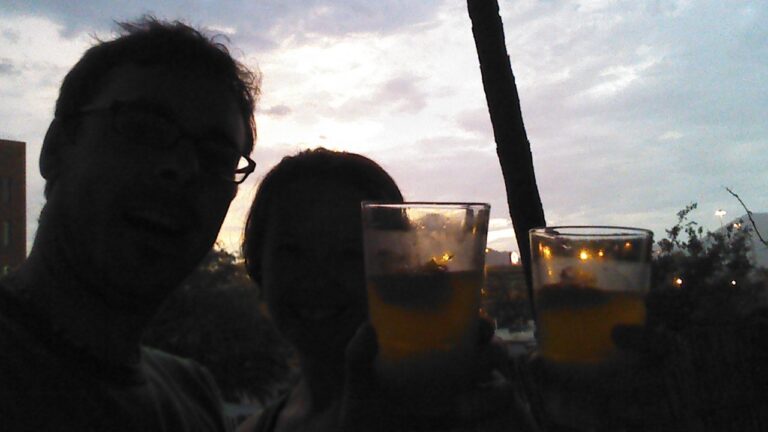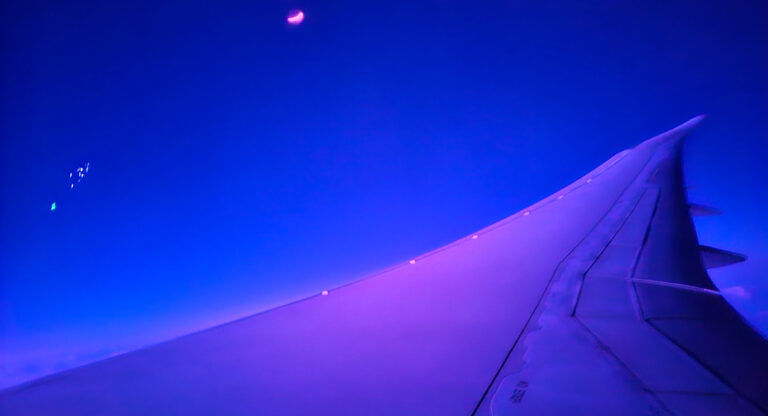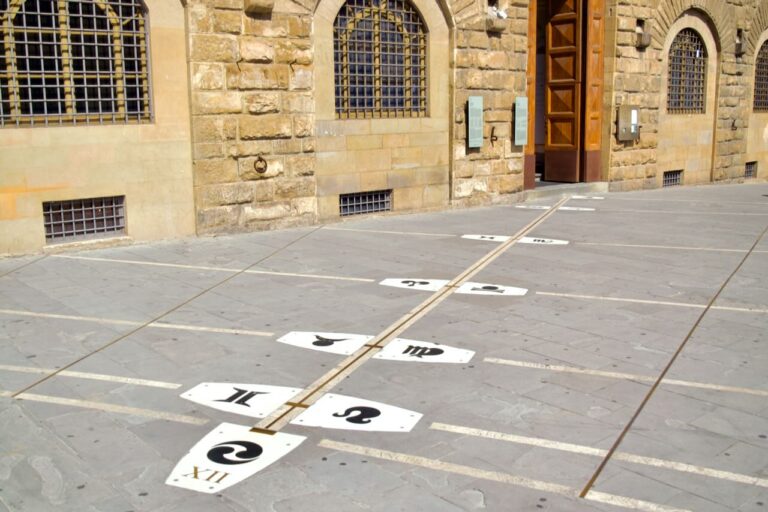Tuesday, September 10th | 2024 | Day 13
Language class began at nine, so Deb and I met in the lobby at PopArtment before making what was by now, a familiar trek to Accademia Europea di Firenze. For the first half, we practiced verb conjugation with Luca. Our cultural instructor Giusy, and a guide, brought us on an excursion for the second half.
Located on Via Porta Rossa just south of Piazza della Repubblica, Palazzo Davanzati was built in the fourteenth century. From the outside, our guide explained how homes were typically structured at the time. Kitchens were on the top floor so that in the event of a fire, it was less likely to spread through the entire house. Bedrooms and private spaces were on the next two floors down, followed by family and dining rooms also used for receiving and entertaining guests below that.
The heavy, reinforced doors as well as stone columns and arches on the ground floor made it feel more like entering a castle than a home. Of course these features were practical as well as political. Strong doors could be barred to keep the family safe should there be an attack or general unrest. Thick supports were needed to bear the weight of four floors above while allowing light and air to circulate throughout. It also projected an image of grandeur, strength, and power so that those who entered knew they were among those with wealth and influence.
Another interesting feature was an elaborate system of pipes that carried rainwater from all four stories above into a cistern below the grand atrium on the ground floor. A system of hooks, ropes and pulleys was built into the walls that allowed water to be hoisted from the cistern to the upper floors. While certainly practical for daily life, it was another insight into how they perhaps planned to survive should the city come under siege, whether by an invading army or their own citizenry.
Continuing to the first floor, the Great Hall was primarily for business transactions. As a woodworker, the heavy, hand crafted furniture was quite interesting and I tried to imagine the exploded plan view as well as the joinery used to connect and fasten the elaborate decorative pieces to the casework.
After moving through several other rooms where our guide provided excellent context and history, we came to a wall that appeared to have graffiti. This was where the Davanzati children had done their homework. Because the streets were filthy and dangerous, and no system of public education yet existed, those who could afford it brought in tutors. Paper to write on was even more costly than private tutelage, so they used the walls.
This was another place I could have spent far more time. The remaining two floors of treasures that offered a much more intimate glimpse into the lives of its inhabitants were unfortunately closed for renovation. If you do make Palazzo Davanzati a stop during your trip to Florence, guided tours are available at no extra cost beyond the price of admission. Check the website for times and pricing.
After all that learning and touring, Bill, Anahi, Deb, and I were famished. On our way to meet up with the tour group, we had just enough time for a quick lunch at La Petite. Spritz and a sandwich with fries, that’s how I roll.
We reconvened with everyone at Caffè Gilli on Piazza della Repubblica. A selection of caffè e dolce was included in the procession of culinary delights arranged by our tour director Nadia.
Throughout most of history, water has not been a safe source for satisfying one’s thirst. As the clarity provided by coffee replaced the haze of beer and wine as the only options, it could be argued that this roasted bean assisted in the rise of several revolutions—Intellectual, Agricultural, and Industrial.
Founded in 1733, and well known for its biscotti, pastry, and espresso, the caffè has long been a gathering place for thinkers, dissidents, poets, and lovers of art and life alike. One can imagine conversations of news and trade arriving from New World colonies, to the occupation of Lucca by Napoleon, and Garibaldi’s vision of a unified Italy being hotly debated in this very spot.
When I was maybe eight or nine, my parents took me and my sister to the Philadelphia Art Museum. I can remember thinking “how many more boring paintings are there?!” Exhibits of aviation and space exploration at the Franklin Institute and Smithsonian were much more enthralling. I still love aviation, but taking art history courses provided a much deeper appreciation for what once seemed boring. So when we arrived at the Uffizi, I was beyond excited to see as many boring paintings as possible.
Uffizi means offices in Italian. Originally established by Grand Duke Cosimo I de’ Medici as an administrative complex to accommodate the burgeoning needs of the government, today it is renowned as the largest collection of Renaissance art in the world. We can again tip our hats to Anna Maria Luisa for preserving this heritage.
I imagined myself languishing in the storied halls and galleries for hours, but our guide moved the tour along rather swiftly. And for good reason. There is far more to see than one could possibly absorb in a lifetime, much less an afternoon. Naturally, he was showing us the highlights.
In his own words, Leonardo da Vinci considered himself more of an engineer than a painter. While I have much respect for his unparalleled genius and the importance of his work, I have to admit being less than impressed. Though fabulously rendered and well composed, the panels and canvases seemed murky and dark. The room was also stuffy and crowded so take my interpretation with a grain of salt.
A debate over whether form is defined by light or line began in the Renaissance and was argued amongst artists, and those who make careers out of studying and interpreting them, for close to four hundred years. This argument was ultimately “won” at the end of the nineteenth and into the early twentieth century when Impressionists, Cubists, and Surrealists started breaking all the rules. Whichever style you prefer, the Uffizi offers a chance to see extraordinary masterpieces that make it difficult to remain firmly entrenched on either side.
The singular word that comes to mind in describing the work of Botticelli is—divine. I had long anticipated seeing the Birth of Venus and Spring up close. Both canvases stood alone, occupying an entire gallery wall which gave them an even greater sense of importance. Certainly on the line side of the argument, subjects and objects hold well defined space against the landscape. Where similar tones blend against features of the same figure or those of others, dark lines are often used to delineate one from the other. Facial features and expressions are given such attention and care that you would recognize the subject if you saw him or her on the street. Light gracefully falling across faces and billowing folds of fabric, then delicately blending into shade and shadow is simply exquisite. The intricacy with which Botticelli seemed to render every strand of hair is one of the most striking aspects of his beautifully distinct technique.
Another artist I most anticipated seeing at the Uffizi was Caravaggio. Often working from a solid black background, subjects are integrated into it, before the action of the scene bursts forth, from darkness into light. A master of chiaroscuro and clearly on the light side of that classic argument, Caravaggio was also a master at capturing pure emotion. The determination of Judith and her servant as she severs the head of the drunken and mystified Holofernes who was set to despoil their homeland. Medusa, in the very moment of realization that she has been vanquished by Perseus, her face contorted in shock and horror. In repose, with a variety of fruit offered, Bacchus wryly lifts a glass of red wine to those who might accompany him in the pursuit of sumptuous pleasure.
Outside of the main galleries, a wide corridor was lined with sculpture representing myths of Greek and Roman origin such as Leda and the Swan, and Cupid and Psyche. Full figures and busts of classical gods, notable leaders, and philosophers that those in the Renaissance reached back to for wisdom and guidance, much as we do today. Portraits of heads of state from the Sultanate, to France and England, to Egypt and North Africa, well known to the ruling class and merchants across the peninsula were hung along the soffits.
One of my favorite bronze statues was Silenus and the Young Bacchus. Holding his infant son in his arms, Silenus beams with the pride and joy that comes from being a father.
After about two and a half hours breezing through some of the most celebrated art and history of the Renaissance age, the tour was over. Though I would have much preferred to linger for days, it was an incredible experience.
From the Uffizi, our group set out for an early dinner at another fine restaurant—the name of which is woefully blank in the day’s journal entry. We sat at a long table in the arcade of the atrium well ahead of their anticipated dinner rush. I do recall the red glow of Campari—the only bottles stacked on the backlit wall of the outdoor bar.
Leave it to Nadia to spoil us with yet another delicious three course meal featuring local wine. It had been an exciting, but long day, and while conversation around the table was as engaging as usual, it also reflected the energy level of tired tourists.
Once we had finished with dinner, the group headed for Stazione Unità. It was a leisurely post-meal stroll through passages quieted after what must seem to locals like invasion on a daily basis. I didn’t know exactly where we were, but had a pretty good sense of the general direction we needed to go. As the narrow streets opened up onto Piazza Santa Maria Novella several others remarked at how familiar I already seemed to be with Florence. There are times when new things just fit like a glove.


